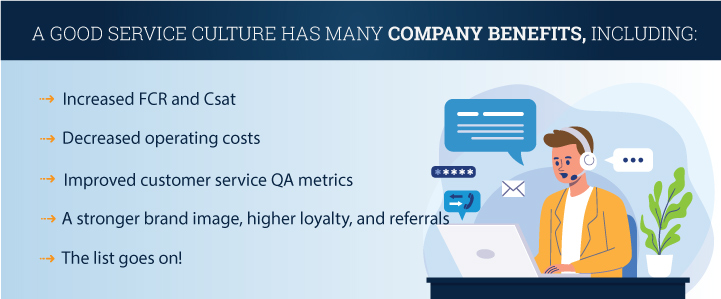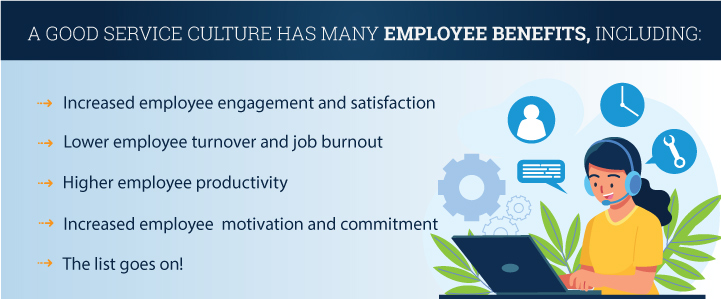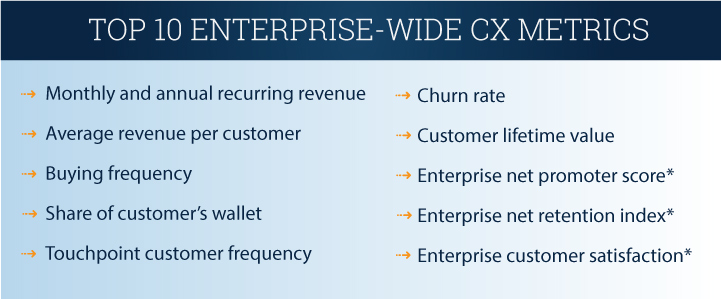Service-Centric Culture
Is your call center focused on delivering great customer experiences or reducing costs? If the call center's primary focus is reducing costs and not providing great customer service, creating a service culture will be an uphill battle.
Creating a service culture can be a considerable challenge for the call center leadership team. It takes time, money, resources, and commitment from the entire company to create an obsession with delivering great customer service. This blog will cover what you need to know about creating a service-centric culture.
What Is a Service Culture?
From a call center’s perspective, service culture is where all employees are obsessed with delivering great customer experiences for resolving an interaction on the first call. This means the call center’s call handling practices are based on putting your customers first to ensure First Call Resolution (FCR) and Customer Satisfaction (Csat) are achieved.
Being service-centric or having a service culture is done by delivering positive customer experiences before, during, and after purchasing a product or service. Moreover, creating a call center service culture requires leaders to align their people, processes, and technology practices to consistently support their employees in delivering a great CX.
Why Is a Good Service Culture Important?
A good customer service culture benefits the company, call center, employees, and, most importantly, customers.


25 Questions to Measure If Your Service Culture Is Strong
A good starting point for measuring if your call center has a strong service culture is to ask the below 25 questions to all your employees. In addition, the service culture questionnaire can help your call center create a customer service-centric culture. The key is to address any areas where agreement is low among employees.
Furthermore, it is common for companies to use a 5-point agreement scale. In conducting service culture surveying, you might discover significant differences among employees and functions within the call center. If you ask employees to complete the service culture questionnaire, you must share the results and any action you are prepared to take. Here are 25 questions to measure if you have a strong service culture:
- Are the leaders of your call center aligned with a customer service-centric culture?
- Do your leaders agree with the call center goals and priorities?
- Are your managers and leaders excellent customer service role models?
- Do your leaders understand the importance of a strong customer service culture?
- Is customer impact a critical part of business decisions throughout the company?
- Do all employees understand who the key customer groups (LoB, segment, etc.) are and what matters to them?
- Do you have enough resources to deliver great customer service?
- Does your call center deliver First Call Resolution 80% or greater rate?
- Does your call center have an established customer-service-centric culture?
- Is the call center function respected and valued throughout the company?
- Does your company regularly share its vision, mission, culture, and value information with all employees?
- Does your call center agree on a clear definition of great customer service?
- Are your employees at the call center there to transform themselves, the company, and customers for the better?
- Do your employees collaborate to make things better for customers?
- Do your employees act like owners to make good decisions and deliver good service?
- Do your training programs have a positive impact on customer service?
- Do your agent desktop applications have a positive impact on customer service?
- Do you recognize employees for their customer service delivery success?
- Does your quality assurance program have a positive impact on customer service?
- Does your call center track and benchmark the right customer service metrics?
- Does your call center use post-call survey feedback consistently to improve customer service and share it with all stakeholders?
- Does your agent coaching have a positive impact on customer service?
- Does your new employee onboarding describe your customer service culture?
- Does the service improvement process seek new ideas from all employees?
- Do you benchmark your customer service performance by touchpoints against competitors and outside your industry?
How To Create a Strong Service Culture?
So far, you have learned more about a service culture; it is important and key questions to measure if your service culture is strong. Now you are ready to learn how to create a strong service culture. You can take many steps to ensure your call center has a strong service culture. Here are seven common business practices for creating a strong service culture.

Whitepaper — How To Create a Customer Service Centric Culture
Based on CX Award-Winning Call Centers
1. Clearly Define How Your Service Culture Is a Big Part of Your Company's Vision, Mission, and Values
Most companies and some call centers have vision, mission, and values statements that are used to share with stakeholders (e.g., employees, customers, vendors, and shareholders). If you do not clearly define how your service culture is a big part of your company’s vision, mission, and values, you must amend it.
When service culture elements are included in your vision, mission, and values, it strongly conveys to all stakeholders that delivering great customer service is a top priority. In addition, SQM considers having a vision, mission, motto with muscle statement, and key performance indicators specific to the call center to be a best practice for defining and communicating their main purpose.
2. Establish and communicate service goals.
Establishing and communicating service goals for the entire company and call center is essential to achieve stakeholder alignment with performance goals. If you don’t, employees won’t know what good service looks like, what is expected of them, or how their performance contributes to great customer service. In addition, you need to share your service goals with all employees so that everyone understands why customer service matters to them personally and professionally.
For example, if great customer service goals are an enterprise-wide initiative, you can use service goals to demonstrate how the call center delivering great customer service will benefit the company. For instance, agents should understand that providing First Call Resolution positively impacts customers' willingness to recommend and continue to do business with the company.
Once everyone understands what great customer service means, they can play an active role in achieving the service goal. In addition, by understanding what great service means, employees will be able to focus on delivering great customer service versus just handling calls and providing mediocre service.
3. Hire employees based on being a strong service culture fit.
One of the essential things you can do to create a strong culture is to hire employees who embody your vision, mission, and values. Put differently, hire for service culture fit.
In fact, one of the most important responsibilities of managing a call center is to hire employees who are a service culture fit for delivering great CX. Therefore, the interview process should be based on hiring for fit to achieve great CX.
Identifying candidates who are a good fit for the agent job to deliver great customer service can be an enormous undertaking. The chances of hiring agents that will provide great customer service can be increased by using the following agent selection four steps:
- Pre-Interview Screening
- Personality/Behavioral Test
- Job Simulation
- Face-to-Face Interview
At SQM, we have developed a predictive index list of 17 behavioral-based agent interview questions that can be asked to determine if an agent candidate would be a good fit for providing great customer service. Click here to download the agent candidate fit interview questionnaire.
Hire or select and develop servant leaders. For example, the servant leadership style is about serving agents who report to them. Put differently, servant leadership relies on the concept that leaders exist to serve agents instead of the other way around. As a result, servant leaders show empathy, are followers, value agents' input, and encourage collective decision-making.
Your supervisors and managers set the tone for their teams. What they value and their leadership style will shape the behavior of their team members, so picking the right leaders and developing them is essential. It is important to emphasize that the most experienced candidate for a leadership position might not be the best choice due to not being a service culture fit.
You Might be a Servant Leader If…
- It is your top priority to develop agents so they can provide great customer service.
- You're known for asking agents how you can help them provide high Csat.
- You place more emphasis on agent needs than yours.
Take Our Leadership Style Questionnaire
Complete the leadership style questionnaire to know and compare your dominant style to other styles.
4. Measure Service Culture Efforts.
At the call center and at the enterprise levels, you need to measure CX to understand if employees are being successful at delivering great customer service. If you are not currently measuring CX, you need to establish a voice of the customer (VoC) system to measure service outcomes, so employees can monitor their efforts.
Not every company will use the same metrics at the call center or at the enterprise-wide level to measure the success of their service centricity for delivering a great CX. SQM’s view is that measuring the success of being customer service-centric should be based on letting the customers judge their experience through a customer survey system.
SQM’s top 10 CX metrics for measuring customer service-centricity success provide valuable insights into customers’ experiences when using a touchpoint or multiple touchpoints to resolve an inquiry or problem and on transactional overall customer relationship performance.
The top 10 call center CX metrics are measured by the VoC post-call survey method. The measurement and reporting of the CX metrics should take place daily. So here are the top 10 customer service metrics used by call centers genuinely committed to being customer service-centric:

Curious about what customer service-centric metrics are used at the enterprise level for leading North American companies that you should be measuring? The top 10 enterprise-wide metrics are measured by a VoC relationship survey method and by internal company metrics.
The measurement and reporting of the CX metrics should take place monthly. So here are the top 10 enterprise-wide CX metrics used by companies genuinely committed to being customer service-centric:

Call center leaders are increasing investments in VoC programs and software that employ a VoC closed-loop process. At SQM, our VoC closed-loop process consists of four steps – Identify, Develop, Check, and Act to improve FCR and customer service performance. Measuring CX is important, but actioning VoC data to drive CX improvement is more important. Put differently, don’t just measure, do something meaningful with the CX data to improve CX.
5. Recognize and Motivate Employees to Provide Great Csat
There’s nothing like receiving recognition from customers, co-workers, and managers when someone goes the extra mile to deliver great CX. For example, it has been my experience recognizing agents for resolving tough customer calls and, at the same time, providing a great CX, which is one of the best practices for improving FCR and Csat. However, very few organizations have a formalized CX recognition program that celebrates agent success in resolving a tough call while providing exemplary service.
At SQM, we believe the Regence BlueCross BlueShield recognition program to be a best practice for recognizing agents for their customer service performance. Regence BlueCross BlueShield's agent recognition program is called Service Hero. Their Service Hero recognition program is the most successful and longest-running recognition program for their company. It recognizes the agents who provide exemplary customer service and provides senior executives with great insights into CX trying to resolve complex healthcare calls.
Any call can be nominated to be a winning Service Hero interaction. The leadership team first reviews the calls in their respective locations. Then, every quarter after vetting within each location, the best Service Hero interaction nominations are sent to the next level of review.
The second level of review is held face-to-face in one of the service locations. Again, a day is set aside for the session attended by the Vice President, Director, Managers, a selection of local supervisors, and other guest leaders within the company. This group will listen to as many as 20 calls, discuss and rank each one, select the top five to seven calls, and then send them to the next level.
The final selection is made by their four business unit Plan Presidents and other senior executives. The Plan Presidents and senior executives listen to the calls and rank them based on the agents' ability to create a truly outstanding experience for their customers.
They consider tenacity in resolving issues, compassion under challenging situations, and the ability to successfully help customers understand complex information, often when customers are faced with the additional challenge of managing costs.
Each service location celebrates the quarterly winners during an all-employee meeting. One of the winning calls is played to allow the entire customer service team to hear an example of excellent service to inspire them to be a Service hero. The winners are recognized in front of peers with an enlarged check for five hundred dollars personally signed by their CEO and a personally engraved gold star statue.
At the year's end, the twelve quarterly Service Hero winners are flown to Portland for a two-day trip. The first day shows appreciation with a fun activity day, gifts, and dinner.
6. Think Strategically & The Big Picture
What Is CX Thinking Strategically?
Customer service strategic thinking involves seeing the big-picture, planning for the future, and allocating resources to implement their plan to gain a competitive advantage in your call center's Csat. Unfortunately, most people think that strategic thinking is only for senior managers.
However, it must happen at every management level in the call center. So ask yourself this question: do you think about the big-picture, or do you need to be more strategic? Unfortunately, SQM research shows that most call center leaders think strategic thinking and the big picture are not as crucial as other leadership qualities. Therefore, most call center leaders have less emphasis on enhancing their strategic thinking skills when compared to other leadership quality skills.
Why is CX Strategic Thinking Important?
SQM believes that call center leaders need to focus more on enhancing their strategic thinking skills. The competitive environment can change quickly for any company or call center. New trends in people, processes, and technology may emerge quickly and require your call center to take advantage of them or fall behind in your Csat performance.
By incorporating strategic thinking into your daily call center work, you will become more skilled at understanding the big-picture, problem-solving, decision-making, resource allocation, and developing action plans to improve Csat performance. Thinking strategically can help you make a greater contribution to your role and become essential to your company. Why? Because leaders that are capable of thinking strategically and the bigger picture can have a tremendous impact on the call center's Csat trajectory.
7. Train Employees On a Service Culture & How to Deliver Csat.
Many call center managers are unaware of the impact of repeat calls on their Csat, agent job satisfaction, and customer retention. SQM is often asked: "How can I get my agents to improve their call resolution and Csat performance?", "How do I reduce customer defections?", "How can I improve these issues as soon as possible?" The answer to these questions can be found by implementing a Call Resolution Delivery agent training program.
The following are call resolution training tips to help agents improve FCR and Csat:
- Provide training to new and existing employees on what is a service culture, why it is important, and how to create a strong service culture
- Train supervisors on how to coach agents to improve VoC performance and to engage agents, so they are motivated to improve FCR, call resolution, and Csat
- Budget and adequately plan for providing agent call resolution two-day training
- Provide call resolution training for both new hires and existing agents
- Hire agents with a customer-centric attitude and train for call resolution skills
- Use job shadowing and peer mentoring for agent new hires or poor agent VoC performers, using agents as the mentor with the highest call resolution and Csat performance as the coach
- Incorporate VoC repeat call reasons and solutions into new hire and ongoing agent training programs
- Provide call resolution classroom and/or e-learning training
-
Use agent VoC customer service reporting software tool that can provide a dashboard view of call resolution and Csat performance and identifies opportunities to improve CX
